The AMD Threadripper 2990WX 32-Core and 2950X 16-Core Review
by Dr. Ian Cutress on August 13, 2018 9:00 AM ESTHEDT Benchmarks: Web and Legacy Tests
While more the focus of low-end and small form factor systems, web-based benchmarks are notoriously difficult to standardize. Modern web browsers are frequently updated, with no recourse to disable those updates, and as such there is difficulty in keeping a common platform. The fast paced nature of browser development means that version numbers (and performance) can change from week to week. Despite this, web tests are often a good measure of user experience: a lot of what most office work is today revolves around web applications, particularly email and office apps, but also interfaces and development environments. Our web tests include some of the industry standard tests, as well as a few popular but older tests.
We have also included our legacy benchmarks in this section, representing a stack of older code for popular benchmarks.
WebXPRT 3: Modern Real-World Web Tasks, including AI
The company behind the XPRT test suites, Principled Technologies, has recently released the latest web-test, and rather than attach a year to the name have just called it ‘3’. This latest test (as we started the suite) has built upon and developed the ethos of previous tests: user interaction, office compute, graph generation, list sorting, HTML5, image manipulation, and even goes as far as some AI testing.
For our benchmark, we run the standard test which goes through the benchmark list seven times and provides a final result. We run this standard test four times, and take an average.
Users can access the WebXPRT test at http://principledtechnologies.com/benchmarkxprt/webxprt/
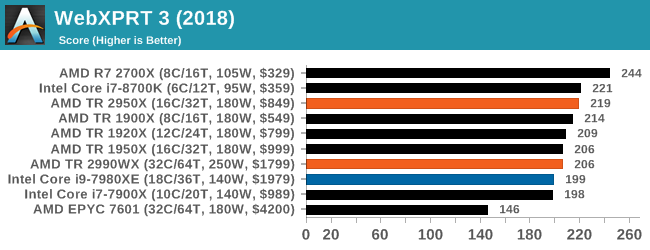
WebXPRT 2015: HTML5 and Javascript Web UX Testing
The older version of WebXPRT is the 2015 edition, which focuses on a slightly different set of web technologies and frameworks that are in use today. This is still a relevant test, especially for users interacting with not-the-latest web applications in the market, of which there are a lot. Web framework development is often very quick but with high turnover, meaning that frameworks are quickly developed, built-upon, used, and then developers move on to the next, and adjusting an application to a new framework is a difficult arduious task, especially with rapid development cycles. This leaves a lot of applications as ‘fixed-in-time’, and relevant to user experience for many years.
Similar to WebXPRT3, the main benchmark is a sectional run repeated seven times, with a final score. We repeat the whole thing four times, and average those final scores.
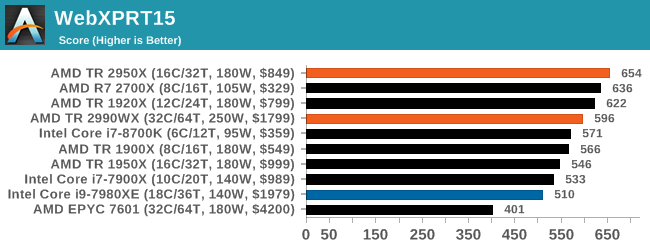
Speedometer 2: Javascript Frameworks
Our newest web test is Speedometer 2, which is a accrued test over a series of javascript frameworks to do three simple things: built a list, enable each item in the list, and remove the list. All the frameworks implement the same visual cues, but obviously apply them from different coding angles.
Our test goes through the list of frameworks, and produces a final score indicative of ‘rpm’, one of the benchmarks internal metrics. We report this final score.
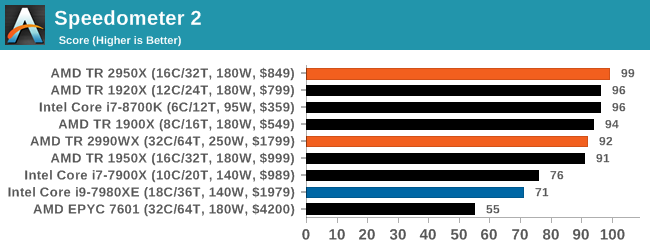
Google Octane 2.0: Core Web Compute
A popular web test for several years, but now no longer being updated, is Octane, developed by Google. Version 2.0 of the test performs the best part of two-dozen compute related tasks, such as regular expressions, cryptography, ray tracing, emulation, and Navier-Stokes physics calculations.
The test gives each sub-test a score and produces a geometric mean of the set as a final result. We run the full benchmark four times, and average the final results.

Mozilla Kraken 1.1: Core Web Compute
Even older than Octane is Kraken, this time developed by Mozilla. This is an older test that does similar computational mechanics, such as audio processing or image filtering. Kraken seems to produce a highly variable result depending on the browser version, as it is a test that is keenly optimized for.
The main benchmark runs through each of the sub-tests ten times and produces an average time to completion for each loop, given in milliseconds. We run the full benchmark four times and take an average of the time taken.
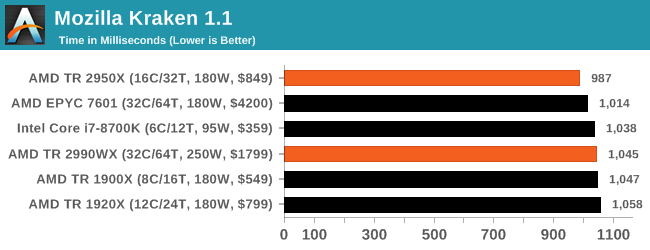
3DPM v1: Naïve Code Variant of 3DPM v2.1
The first legacy test in the suite is the first version of our 3DPM benchmark. This is the ultimate naïve version of the code, as if it was written by scientist with no knowledge of how computer hardware, compilers, or optimization works (which in fact, it was at the start). This represents a large body of scientific simulation out in the wild, where getting the answer is more important than it being fast (getting a result in 4 days is acceptable if it’s correct, rather than sending someone away for a year to learn to code and getting the result in 5 minutes).
In this version, the only real optimization was in the compiler flags (-O2, -fp:fast), compiling it in release mode, and enabling OpenMP in the main compute loops. The loops were not configured for function size, and one of the key slowdowns is false sharing in the cache. It also has long dependency chains based on the random number generation, which leads to relatively poor performance on specific compute microarchitectures.
3DPM v1 can be downloaded with our 3DPM v2 code here: 3DPMv2.1.rar (13.0 MB)

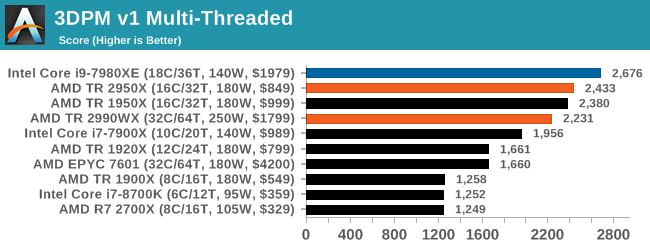
x264 HD 3.0: Older Transcode Test
This transcoding test is super old, and was used by Anand back in the day of Pentium 4 and Athlon II processors. Here a standardized 720p video is transcoded with a two-pass conversion, with the benchmark showing the frames-per-second of each pass. This benchmark is single-threaded, and between some micro-architectures we seem to actually hit an instructions-per-clock wall.
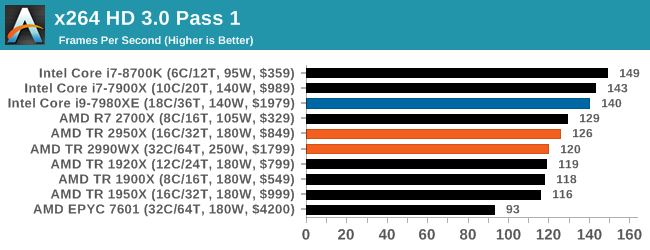
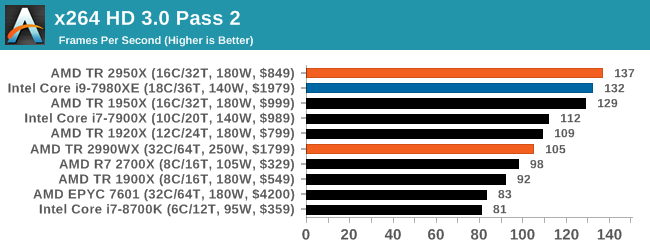










171 Comments
View All Comments
Lolimaster - Monday, August 13, 2018 - link
I don't really see a point OCing the 2990WX, it seems quite efficient at stock setting with an average of 170w fully loaded, why go all the way to 400w+ for just 30% extra performance, it already destroys the 2950X/7980XE OCed to hell beyond repair.Lolimaster - Monday, August 13, 2018 - link
Threadripper 2990WX = Raid Bossyeeeeman - Monday, August 13, 2018 - link
Amazing performance from AMDs part. If you want to see a real review of 2990WX from a reviewer who understands how this CPU will be used, please check https://www.phoronix.com/scan.php?page=article&...mapesdhs - Monday, August 13, 2018 - link
Figured it would be those guys. 8) I talked to them way back when they started using C-ray for testing, after the original benchmark author handed it over to me for general public usage, though it's kinda spread all over the place since then. Yes, they did a good writeup. It's amusing when elsewhere one will see someone say something like, these CPUs are not best for gaming! Well, oh my, what a surprise, I could never have guessed. :DIn the future though, who knows. Fancy a full D-day simulator with thousands of players? 10 to 20 years from now, CPUs like this might be the norm.
eva02langley - Tuesday, August 14, 2018 - link
It is exactly what I said. If we don't have a proper test bed for a unique product like this, then the results we are going to provide are not going to be representative of the true potential of a CPU like this.Sites will need to update their benchmarks suites, or propose new review systems.
Gideon - Monday, August 13, 2018 - link
Great article overall. The Fabric Power part was the most interesting one! Though you might want to check The Stilt's comments regarding that:https://forums.anandtech.com/threads/2990wx-review...
and:
https://forums.anandtech.com/threads/2990wx-review...
Icehawk - Monday, August 13, 2018 - link
Ian, for in progress articles can they please be labelled that way? I would rather wait for the article to be complete than read just a few pages and have to check back hoping it has been updated.mapesdhs - Monday, August 13, 2018 - link
Ian, can you add C-ray to the multithreaded testing mix please? Becoming quite a popular test these days as it can scale to hundreds of threads. Just run at 8K res using the sphract scene file with a deep recursion depth (at least 8), to give a test that's complicated enough to last a decent amount of time and push out to main RAM a fair bit aswell.abufrejoval - Monday, August 13, 2018 - link
Ok, I understand it we are all enjoying this pay-back moment: Intel getting it on the nose for trying to starve AMD and Nvidia by putting chipsets and GPUs into surplus transistors from process shrinks, transistors that couldn’t do anything meaningful for Excel (thing is: Spreadsheets would actually be ideal for multi-cores even GPGPU, you just need to rewrite them completely…)But actually, this article does its best to prepare y’all for the worst: Twice the cores won’t be twice the value, not this time around, nor the next… or the one after that.
Please take a moment and consider the stark future ahead of us: From now on PCs will be worse than middle class smartphones with ten cores, where it’s cheaper to cut & paste more cores than to think of something useful.
KAlmquist - Monday, August 13, 2018 - link
I'm not sure AMD would have bothered with the 2990WX if it weren't for the Intel Core i9 7980XE. With 18 cores, the 7980XE beats the 16 core Threadripper 2950X pretty much across the board. On the other hand, if you running software that scales well across lots of cores--and you probably are if you're considering shelling out the money for a 7980XE--the 32 core 2990WX will be faster, for about $100 less.These are niche processors; I doubt either of them will sell in enough volume to make a significant difference to the bottom line at Intel or AMD. My guess is that both the 2990WX and the 7980XE were released more for the bragging rights than for the sales revenue they will produce.